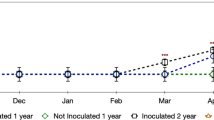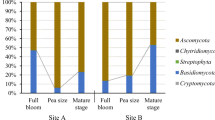Abstract
The effect of nutrients on Colletotrichum gloeosporioides, the cause of avocado anthracnose, and on microorganisms that are antagonistic to the pathogen was studied in a series of laboratory and field experiments. Avocado (cv. Hass) leaves sprayed once with molasses, urea and yeast extract, either alone or in combination, were sampled after 7 and 28 days and populations of bacteria, yeasts and filamentous fungi on the leaf surface were determined. Urea had little effect on the number of microorganisms, but molasses increased microbial populations by 10- to 100-fold. When the antagonistic yeasts Cryptococcus sp. and Aureobasidium sp. were sprayed onto avocado leaves in the field with molasses, they maintained significantly higher populations than in the absence of molasses. However, molasses did not enhance populations of selected antagonistic bacteria (e.g. Pseudomonas fluorescens, Pantoea sp. and Bacillus pumilus) when sprayed on leaves. Molasses increased the saprophytic growth of C. gloeosporioides on detached avocado fruit and these fruit developed more disease than fruit treated with water alone. Detached avocado fruit treated with antagonistic yeasts, Cryptococcus sp., Aureobasidium sp. or pink yeast 734 in the presence or absence of molasses had fewer and smaller lesions than fruit without added yeasts. Regular molasses sprays applied to avocado trees in the field over an 8-month period did not increase anthracnose in fruit.
Similar content being viewed by others
References
Andrews, J.H. (1992) — Biological control in the phyllosphere. Annual Review of Phytopathology 30: 603–635.
Andrews, J.H. and Kenerley, C.M. (1978) — The effects of pesticide program on non-target epiphytic microbial populations of apple leaves. Canadian Journal of Microbiology 24: 1058–1072.
Bashi, E. and Fokkema, N. J. (1977) — Environmental factors limiting growth of Sporobolomyces roseus, an antagonist of Cochliobolus sativus, on wheat leaves. Transactions of the British Mycological Society 68: 17–25.
Blakeman, J.P. and Brodie, I.D.S. (1977) — Competition for nutrients between epiphytic micro-organisms and germination of spores of plant pathogens on beetroot leaves. Physiological Plant Pathology 10: 29–42.
Blakeman, J.P. and Parbery, D.G. (1977) — Stimulation of appressorium formation in Colletotrichum acutatum by phylloplane bacteria. Physiological Plant Pathology 11: 313–325.
Brodie, I.D.S. and Blakeman, J.P. (1975) — Competition for carbon compounds by a leaf surface bacterium and conidia of Bobytis cinerea. Physiological Plant Pathology 6: 125–135.
Burchill, R.T. and Cook, R.T.A. (1971) — The interaction of urea and micro-organisms in suppressing development of perithecia of Venturia inaequalis (Cke.). In Ecology of Leaf Surface Micro-organisms (Eds T.F. Prcece and C.H. Dickinson), pp. 471–483. Academic Press, London.
Crosse, J.E., Garrett, C.M.E. and Burchill, R.T. (1968)— Changes in the microbial population of apple leaves associated with the inhibition of the perfect stage of Venturia inaequalis after urea treatment. Annals of Applied Biology 61: 203–216.
Dik, A.J., Fokkema, N.J. and van Pelt, J.A. (1992) — Influence of climatic and nutritional factors on yeast population dynamics in the phyllosphere of wheat. Microbial Ecology 23: 41–52.
Emmett, R.W. and Parbery, D.G. (1975) — Appressoria. Annual Review of Phytopathology 13: 147–167.
Fokkema, N.J. (1973) — The role of saprophytic fungi in antagonism against Drechslera sorokiniana (Helminthosporium satiwm) on agar plates and on rye leaves with pollen. Physiological Plant Pathology 3: 195–205.
Fokkema, N.J., den Houter, J.G., Kosterman, Y.J.C. and Nelis A.L. (1979) — Manipulation of yeasts on fieldgrown wheat leaves and their antagonistic effect on Cochliobolus sativus and Septoria nodorum. Transactions of the British Mycological Society 72: 19–29.
Fokkema, N.J., Dik, A.J. and Daamen, R.A. (1987) — Use of carbendazim and carbendazim-resistant yeasts to create different yeast densities on wheat leaves for field studies on biological control. Netherlands Joumal of plant Pathology 93: 273–283.
Grover, R.K. (1971) — Participation of host exudate chemicals in appressorium formation by Colletotrichum piperaturn. In: Ecology of Leaf Surface Micro-organisms (Eds T.F. Preece and C.H. Dickinson), pp. 509–518. Academic Press, London.
Leben, C. and Daft. G.C. (1965) — Influence of an epiphytic bacterium on cucumber anthracnose, early blight of tomato, and northern leaf blight of corn. Phytopathologv 55: 760–762.
Leben. C., Daft, G.C., Wilson, J.D. and Winter, H.F. (1965) — Field tests for disease control by an epiphytic bacterium Phytopathology 55: 1375–1376.
Lindow, S.E. (1988) — Lack of correlation of in vitro antibiosis with antagonism of ice nucleation active bacteria on leaf surfaces by non-ice nucleation active bacteria. Phytopathology 78: 444–450.
Morris, C.E. and Rousse, D.I. (1985) — Role of nutrients in regulating epiphytic bacterial populations. In: Biological Control on the Phylloplane (Eds C.E. Windels and S.E. Lindow), pp. 63–82. American Phytopathological Society, St. Paul, USA.
Parbery, D.G. (1981) — Biology of anthracnoses on leaf surfaces. In: Microbial Ecology of the Phylloplane (Ed J.P. Blakeman), pp. 135–154. Academic Press, London.
Paturau, J.M. (1989) — By-products of the Cane Sugar Indushy: an Introduction to their Industrial Utilization. Third Ed. Elsevier Science Inc. Amsterdam.
Snedecor, G.W. and Cochran, W.G. (1980) — Statistical Methods. Seventh Ed. The Iowa State University Press, Iowa, USA.
Stirling, A.M. (1996) — The role of epiphytic microorganisms in the suppression of Colletotrichum gloeosporioides on avocado. PhD Thesis, The University of Queensland.
Stirling, A.M., Coates, L.M., Pegg, K G and Hayward, A.C. (1995) — Isolation and selection of bacteria and yeasts antagonistic to preharvest infection of avocado by Colletotrichum gloeosporioides. Australian Journal of Agricultura1 Research 46: 985–995
Stirling, A.M., Hayward, A.C. and Pegg, K.G. (1992) — Evaluation of the biological control potential of bacteria isolated from a soil suppressive to Phytophthora cinnamomi. Australasian Plant Pathologv 21: 133–142.
Williamson, M.A. and Fokkema, N.J. (1985) — Phyllosphere yeasts antagonise penetration from appressoria and subsequent infection of maize leaves by Colletotrichum graminicola. Netherlands Journal of Plant Pathology 91: 265–276.
Wilson, M. and Lindow, S.E. (1992) — Relationship of total viable and culturable cells in epiphytic populations of Pseudomonas syringae. Applied and Environmental Microbiology 58: 3908–3913.
Wilson, M. and Lindow, S.E. (1994) — Coexistence among epiphytic bacterial populations mediated through nutritional resource partitioning. Applied and Environmental Microbiology 60: 4468–4477.
Author information
Authors and Affiliations
Corresponding author
Rights and permissions
About this article
Cite this article
Stirling, A.M., Pegg, K.G. & Hayward, A.C. Interaction of Colletotrichum gloeosporioides, epiphytic microorganisms and nutrients on avocado leaves and fruit. Australasian Plant Pathology 27, 169–179 (1998). https://doi.org/10.1071/AP98019
Received:
Accepted:
Issue Date:
DOI: https://doi.org/10.1071/AP98019




